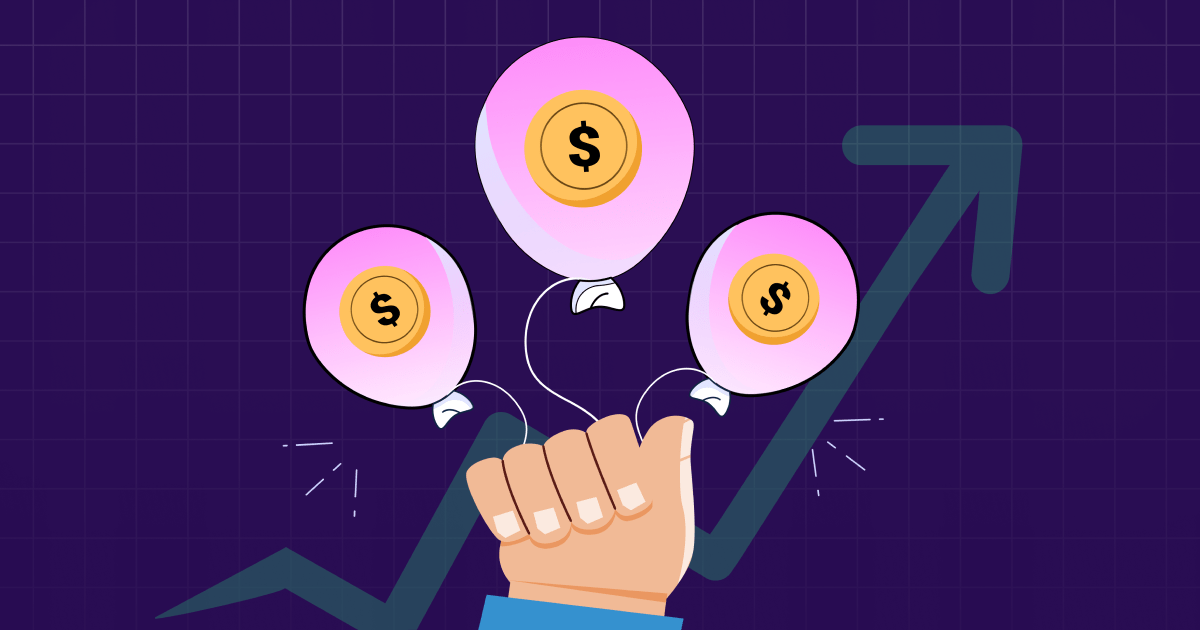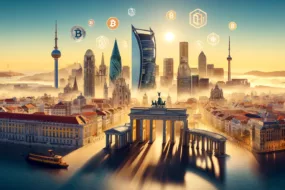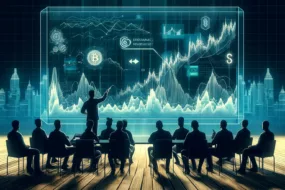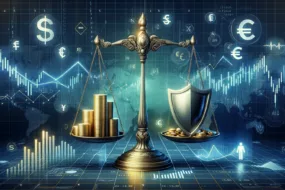
Inflation has been the talk of the town for the last couple of years, with almost everyone at the micro and macro levels discussing and predicting it. Inflation is a monetary phenomenon that reduces the purchasing power of people like us, and we have to pay more money in exchange for goods and services.
That was a very basic explanation of what is inflation, which you would have learned if economics was part of your school curriculum. Even if it wasn’t, don’t worry, because in this article, we will dive deep into this topic in layman’s terms so that even those of you that had other majors can confidently speak the terms of an economist! Let’s get started.
What Is Inflation? A Monetary Phenomenon
Inflation is simply the rise in prices. This rise in prices can be translated into deteriorating purchasing power.
Let’s try to understand this with a simple example. If you can buy 1 pizza at Rs. 100 currently, due to inflation, the same pizza will cost you Rs. 106 after one year, assuming a 6% inflation rate. That’s inflation entering the chat and your purchasing power declining.
This drop in purchasing power is reflected in all the goods and services we use. As a human, our needs go beyond one or two products. Hence inflation indexes measure the overall price change of a variety of inputs like grains, metals, fuels, electricity, etc.
However, bear in mind that inflation is not always detrimental. Rising prices can also be an indication of a growing economy.
What Are the Types of Inflation?
Now that you know what inflation is, let’s move on to the types of inflation.
1. Demand-pull inflation
This is one of the most frequently occurring inflation types. Demand-pull inflation occurs when the demand for goods and services rises, but on the other hand, the supply either stays the same or declines. This can be a result of an increase in the money supply in the system leading to an increased demand for goods and services.
A classic example is the demand for new cars that rose more quickly than anticipated after the pandemic. Automakers were already struggling with chip shortages, and the increase in demand led to a double whammy. This, in turn, increased the price of automobiles as demand was higher than supply.
2. Cost-push inflation
This inflation occurs when the supply of goods and services reduces but the demand is still the same or rises. The prices increase, and the outcome is inflation.
For example, commodity prices rose sharply during the pandemic due to turbulence in the supply chain; these increased prices resulted in a higher inflation rate.
3. Built-in inflation
This inflation is unique because its existence is not due to any demand or supply disruption but due to the behavioral aspects of the workers. Workers and employees ask for a raise to live a sustainable life with the rising costs of goods and services. Businesses agree to increase their wages. However, to compensate themselves for compromised profit margins, businesses increase the prices of their products or services.
This loop continues, and inflation keeps on rising. This is also a common inflation type that exists in a majority of countries.
What Are the Main Causes of Inflation?
We hope that you have understood inflation and its types. Let’s see what factors cause inflation and hurt your purchasing power.
1. Increase in the money supply
This can be a result of printing more money, lower interest rates, increased wages, etc. When the central bank lowers the interest rates, banks start giving easy and lower-interest credit to borrowers. This leads to increased spending power and ultimately results in inflation with rising prices of goods and services as people have more money on hand to spend it.
2. Tax reduction
When the government provides tax subsidies or reduces the tax rates, people have more money on hand, and more money means increased spending, leading to higher demand and prices.
3. Government spending and deficit
Government spending is directly related to the total output of goods and services. When a government infuses more money into the system, people have excessive money to spend. This creates inflationary pressure. Also, this ultimately widens the fiscal deficit and may result in the government printing more money.
After a certain point, printing money can result in a higher velocity of cash circulation, and the cycle continues. We can take the example of Zimbabwe, Africa. The country started printing more and more money to help people manage the cost of living. However, this resulted in hyperinflation. So much so that, in 2008, 1 USD = 231 million Zimbabwean dollars; a 231,000,000% hike.
A few other causes of inflation include:
- Population growth
- Hoarding of goods by consumers
- Shortage of goods and services
- Higher exports
- Depreciating value of currency
- Unexpected/unnatural fluctuations in prices of goods and services in the international market
How Is Inflation Measured?
There are two ways to measure inflation.
1. Consumer Price Index (CPI)
We, as consumers, are more concerned with this price index. The Consumer Price Index, known as the CPI, measures the weighted average price of goods and services that are quintessential to consumers, i.e., oil, transportation, food grains, medical care, and more.
CPI calculation involves dividing the price of these goods and services by their price in the base year and then multiplying that value by 100. The prices taken are the ones that we pay for goods and services in the retail market.
CPI = (Cost of goods and services at present / Cost of goods and services in the previous year) X 100
CPI assesses the cost of living. As a result, it is one of the most important measures to calculate inflation.
2. Wholesale Price Index (WPI)
As the name indicates, this index measures prices at the wholesale level, i.e., factory production. It accounts for inflation before goods and services enter the retail market. WPI is dynamic and differs from country to country. The basket of goods here includes raw materials such as yarn, steel, cotton, etc.
WPI= (Current Price of goods and services / Base Period Price) × 100
How Does Inflation Affect the Economy?
There are many areas of the economy where inflation leaves its mark. Let us discuss some of them.
1. Asset inflation
This is the most crucial aspect that we need to pay attention to. A rise in inflation often leads to the prices of an asset getting sky high. This often leads to people finding it hard to purchase an asset such as a house. However, not every asset gets impacted in a linear way.
Some assets may witness an exponential rise, while other assets might face a decline during the same period. An illustration of this leads us back to 2008 when the Global Financial Crisis took place. Home prices during that time took a dip, while oil prices crossed $100 per barrel.
2. Effect on retirement planning
Retirement is the second innings of life, and people save for this stage of life for years. However, inflation is the silent tax that can reduce the retirement corpus. The corpus set aside for retirement will lose value due to the rise in living costs and currency depreciation.
This can result in a compromised lifestyle. Hence, to preserve the value of retirement, asset allocation should be done efficiently to get higher inflation-adjusted returns.
3. Impact on treasury bonds
Treasury bonds are nothing but the bonds issued by the US government. We can compare it with the bonds issued by any country’s government or central bank. Here, investors invest money at a fixed rate and get returns at maturity.
The main purpose of these bonds is that the government gets money on credit. However, because the interest rate is fixed for a few years, if inflation rises, the return on these bonds reduces. It leads to the government increasing rates and results in a higher cost of funding for them. The result? A higher interest rate for borrowing money as banks raise rates.
4. Overall impact on cost of living
Cost of living is where we see inflation impacting us the most. With increased prices of goods and services, we get less for the same amount of cash. We need higher wages; in turn, companies raise their cost, and the prices increase further.
The vicious cycle continues, and this phenomenon reduces our purchasing power with time. For example, house prices before 20 years were a lot lower than they are right now. The cost of living increased in a literal sense!
Does Inflation in the Economy Affect Everyone?
Inflation is rise in prices. Thus, it is inevitable and would hurt everyone in the economy. However, the impact would have different magnitudes.
- Inflation causes a nation’s currency to depreciate.
- Government borrowings become challenging because of depreciated currency and higher interest rates.
- The government’s fiscal deficit widens as a result.
- Exporters benefit as they receive higher value for their goods due to depreciated currency.
- The opposite happens for the importers as foreign goods become more expensive.
- Consumers face a predicament due to a decline in purchasing power. They rush to buy goods, leading to hoarding. However, this ultimately results in higher prices and increased inflation.
- To combat inflation, central banks raise interest rates.
- Banks transfer this rate hike to consumers and increase their cost of borrowing.
- It means loans become expensive for consumers, and the money supply gradually reduces.
What Is the Difference Between Inflation and Deflation?
Let’s move to the other end of the spectrum—deflation. It refers to a consistent fall in prices of goods and services and is the exact opposite of inflation. Let’s discuss the differences in more detail.
| Inflation | Deflation |
| Substantial and consistent rise in the prices of goods and services is known as inflation. | Consistent and substantial fall in the prices of goods and services is known as deflation. |
| Inflation results in a fall in the purchasing power of consumers. | Deflation results in an increase in the purchasing power of consumers. |
| Money circulation in the economy reduces. | Money circulation in the economy increases as people have more money to spend. |
| Inflation is considered beneficial to the producers due to higher demand and higher prices. | Deflation is considered beneficial to consumers with lower price levels. |
| Inflation results in the depreciating value of a currency, increased fiscal deficit, higher cost of living, increased interest rates, etc. | A country’s currency appreciates, and the fiscal deficit narrows. Deflation results in reduced investment activity because investment return rates are lower. Banks reduce interest rates to make borrowing attractive. |
Conclusion
From getting to know what inflation is to what causes inflation, we are sure that your learning curve would be great. At present, inflation is soaring high, with the US and the UK reaching a 40-year high rate on a Y-OY basis, surpassing 9%. In India, we have an analogous situation with an inflation rate of 7% for August. While there cannot be any prediction in inflation levels, to counter it, investing money in high-interest instruments has no alternative.
FAQs
1. Can inflation cause recession?
While inflation does not cause a recession in the short term, in the long term, the measures taken to curb inflation may lead to a recession. Central banks typically raise the interest rate, and that results in a lower money supply. If the measures are too extreme, a lower money supply leads to a recession.
2. Which inflation index and inflation rate to use?
As a consumer, the inflation index that can affect you the most is the Consumer Price Index. Since this inflation affects the prices of foods and utilities, the CPI rate should be taken into consideration. However, as an additional measure, you can also check the WPI to know the rate of wholesale goods.
3. What is inflation without food and energy?
Inflation that does not include food and energy is called core inflation. Because the rates of food and energy tend to be volatile, they are excluded from calculating core inflation. It is also called the Core Personal Consumption Expenditures Index Excluding Food and Energy or Consumer Price Index for All Urban Consumers Less Food and Energy.
4. What investment assets are inflation-proof?
While inflation affects many assets, investing in a few asset classes is beneficial to gain inflation-proof returns. These assets include equity instruments such as stocks, ETFs, and mutual funds. Additionally, you can also invest in gold, real estate or Real Estate Investment Trusts (REITs) , and digital assets like cryptocurrencies, NFTs, etc. to hedge inflation. Speaking of digital assets that you can invest in, check out Mudrex Coin Sets.




